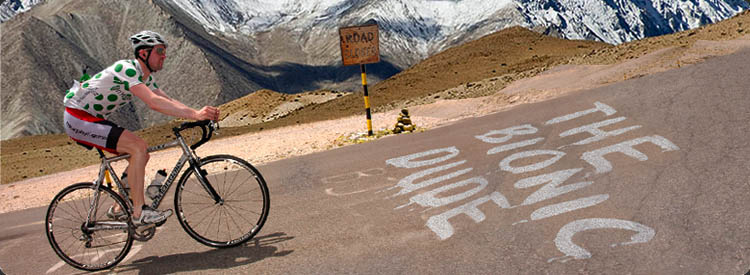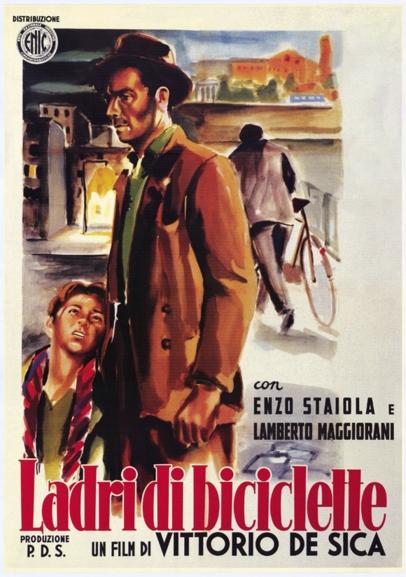**** Boredom Alert - This is a MONSTER post and is not as much fun as Tintin's own escapade in Tibet. Apologies for taking up so much of your reading time but Tibet is a difficult subject to skim. Hopefully you will find it interesting ****
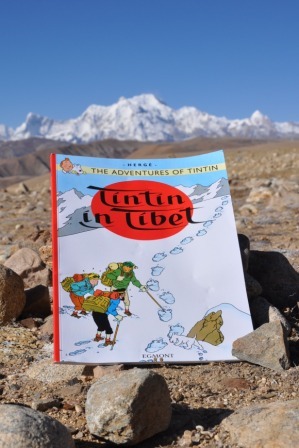 A while ago this intrepid young reporter spent time in the mythical country of Tibet. Somehow I failed to post on the experience despite it being one of the most interesting places I have visited. This is likely because the political situation required me to research it a little more. Indeed, my curiosity about Tibet was the main reason for me being in that part of the world. I had hoped to bike across the Tibetan Plateau from Lhasa to Kathmandu but Asia is not a place where you can organise things on a whim as it takes a lot of time to acquire visas. There is a lot of inaccuracies on the www in terms of transiting through this part of the world and there is also the possibility of border closures. Thus, it would be best to plan such a trip on the ground from the Beijing side if one wanted to ride through unassisted or from the Kathmandu side if one wanted to be part of a fully-supported Tour. This post may have inaccuracies, thus, please post a comment if you feel I have missed something or if you can help complete the picture. Naturally the best way to learn more about a country so rich in nature, tradition and mystique is to visit it. Indeed the desolate scenery is breath-taking and worth the trip alone.
A while ago this intrepid young reporter spent time in the mythical country of Tibet. Somehow I failed to post on the experience despite it being one of the most interesting places I have visited. This is likely because the political situation required me to research it a little more. Indeed, my curiosity about Tibet was the main reason for me being in that part of the world. I had hoped to bike across the Tibetan Plateau from Lhasa to Kathmandu but Asia is not a place where you can organise things on a whim as it takes a lot of time to acquire visas. There is a lot of inaccuracies on the www in terms of transiting through this part of the world and there is also the possibility of border closures. Thus, it would be best to plan such a trip on the ground from the Beijing side if one wanted to ride through unassisted or from the Kathmandu side if one wanted to be part of a fully-supported Tour. This post may have inaccuracies, thus, please post a comment if you feel I have missed something or if you can help complete the picture. Naturally the best way to learn more about a country so rich in nature, tradition and mystique is to visit it. Indeed the desolate scenery is breath-taking and worth the trip alone.
The simplest way to introduce modern-day Tibet is to draw a parallel with the Troubles in my home country of Ireland. Wherever one sees huge numbers of a national flag accompanied by a heavy military presence one knows that there is political rift. The difference with Tibet is that there is only one national flag in evidence; the Chinese flag. This sits atop almost every dwelling. Picture how it would feel for a unionist family in Belfast to have a tricolour floating on their roof-top or vice-versa. Of course, Ireland is an island and a small one at that, so on a geographical level one must question how there came to be a political border within it. Tibet's geography is also at odds with the Chinese power that occupies it. Tibet is the size of France, Germany and Spain combined and sits atop a plateau at roughly 4000ms in altitude. It is effectively a massive island in the sky. In addition, their rouge cheeks contrast with the sallow yellow skin of the Chinese, they speak a different language and they have very a very different Buddhist tradition. This tradition is at total odds with the more orthodox Chinese one. On a very simple level it is very difficult to fathom why the Chinese government considers it part of their already huge country at all.
From a Chinese perspective, they look back through history and see that Tibet was once part of the same empire. However, when does a country's existence begin and end? The Chinese government would not be impressed if Mongolia strived to reclaim all the lands of Genghis Khan. Occupation of Tibet allows China to secure a border closer to India, which suits them from both a political and trade point of view. Occupation also gives them access to Tibet's rich mineral deposits. The Chinese have always desired the reclamation of Tibet, however, the Tibetan government over the centuries never took the threat seriously preferring to dispatch diplomats only when necessary. Indeed their attitude towards the Chinese was somewhat haughty and this proved to be their undoing. By the time the government in Lhasa realised that the Chinese were invading back in the 1950's the Chinese were already moving through the provinces. While the locals did manage to defend themselves they were never in a position to win a war and so the capital Lhasa ultimately fell into the hands of the Chinese. It was during the 'Cultural Revolution' of 1959 that the spiritual head of the people, the Dalai Llama, managed to escape on horse-back. It was a controversial decision to desert his besieged people, however, the decision to escape was taken as reparation of Chinese relations seemed hopeless near-term and so it would be easier to advance the cause of his people safely from outside. Indeed the cavalcade made their way through the Himalaya to Northern India where the local government provided for them. To this day Dharamsala has been home to the Dalai Lama and the Tibetan government in exile. The Chinese were absolutely fuming that the Dalai Lama managed to slip out of the country unnoticed. The charming nature of the incumbent Dalai Lama and his spiritual teachings have made him a cult figure in the western world. His intelligence, compassion and diplomacy have won him many friends in political circles such that he has proved to be a constant thorn in the Chinese side. Of course, it would be naive to think that the US or British government actually care about the Tibetan cause, they simply bring up the disappearance of the Panchen Lama and the plight of the Tibetan people during trade negotiations with the Chinese to humiliate them and increase their bargaining power. It works. So much so that the Tibetan situation is now as much a case of national pride for the Chinese as anything else.
The 'Cultural Revolution' as it is known was effectively ethnic cleansing. The Chinese government passes this off as the 'Peaceful Liberation of Tibet', however, it was only peaceful in the sense that the Tibetans did not have the means to tackle the bully. Indeed, despite some initial pockets of violent resistance in the mountains, such guerillas disbanded when the Dalai Lama desired a peaceful resolution to the problem. Tibetans idolise the Dalai Lama and will always to do as he asks. The stories that have emerged over the many years suggest that it was a particularly gruesome occupation and that there was a lot of bloodshed. The Chinese pillaged and destroyed all the Buddhist monasteries in an attempt to cure the Tibetans of their delusional beliefs. They only saved certain monasteries due to the need to store all the vast riches that were housed within them. It was their failure to stamp out Tibetan' beliefs that caused the Chinese government the most astonishment. They did not realise that by taking away the thing that was most dear to the Tibetans that it would in fact unite Tibetans and make their beliefs stronger. Indeed, during times of persecution or suffering we all resort to our spiritual beliefs as a means of consolation. No matter what the Chinese tried they could not eradicate Tibetan Buddhism. Thus, came the big calm where the Chinese relaxed their persecution of the Tibetans. Not all Tibetans trusted the Chinese after what they had been through but some openly began to reaffirm their faith publicly. There was a long period where relations between Tibetans and the Chinese seemed to improve, however, this was simply a tactic by the Chinese. The idea was to bring the 'poison' out into the open in order to lance it with a spear. Thus, the pious revealed themselves during the calm and subsequently met a grim end as they simply vanished.
In recent years China has opened the Tibetan border to small groups of tourists in the hope of showcasing to the western world the ways in which they have developed Tibet. It is ironic that they opened it as the border was never really open in the first place. Part of the mystique of Tibet was that nobody knew what was going on there. Lhasa was always the Forbidden City and outsiders were very rarely allowed in. Foreign policy as far as the Tibetans were concerned was to keep themselves to themselves such that nobody would ever think about them. If people knew little about Tibet then they would not desire it. The Tibetan Plateau would be a particularly difficult place to invade in any case as the winters are so cold, the mountains so high and the plains so vast. Stories about prognosticating oracles and levitating monks increased the mysticism. Regardless, the Chinese opened the border to tourists in the nineties in an effort to improve diplomatic relations and earn some tourist dollars. They have spent a fortune on infrastructure. The roads in Tibet must be among the best sealed roads in the world. Indeed, Lhasa and Shigatse are now modern cities with fast-food outlets and malls. On the surface it looks like the Chinese have tried to modernise Tibet, however, the truth is that all infrastructure development was for the Chinese' own ends. The airports and roads were built to allow easier access for the military and the Chinese population that would be transplanted there. The reason that Tibetans are so 'backward' is that they don't desire these things in the first place. They are no less intelligent than anyone else, they just don't believe in the need for cars, combine harvesters, electricity or materialism. They don't even need watches as they use more natural things such as the first or second crowing of the cock as reference points. Everything they do has a traditional basis and while their beliefs can hinder 'progress' they get by. For example, any of the infrastructure development they do undertake can take an age as if a worm is uncovered during a dig, then great efforts are made to ensure its safety. I can only imagine the amount of worms that have been spared death by a shovel.
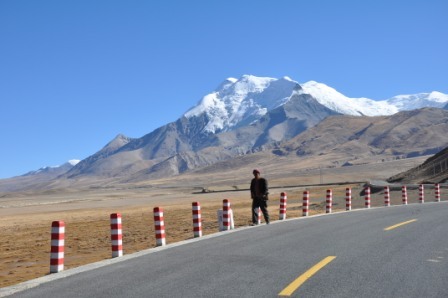 Chinese Infrastructure Programme
Chinese Infrastructure Programme
The prognosis for Tibetans is bleak. While the Chinese have a more relaxed approach to them now that they have a stranglehold, it is difficult to see how Tibetans can reclaim their freedom and their beliefs among so many transplanted Chinese. At last they are allowed to flutter their traditional prayer flags. These flags are everywhere but are typically located on mountain peaks where the strong winds will blow their prayers to the Buddhas. They are even alongside the Chinese flag imposed on their roof tops in lieu of the fact that they can't fly their own flag. They openly practice their beliefs once more, always spinning their prayer wheels as they march laps of the Potala Palace or the Jokhang Temple. The monasteries have regained relatively large populations of Buddhist monks, although they all seem to carry mobile phones and are paid by the government. Monasteries are being restored by the Chinese, however, this is mostly for appearances. When the tourists leave, works tend to stop and the work they did do is repeated the next day for the next wave of tourists such that nothing is ever completed. The Chinese have in the main rehoused them in modern but traditionally styled Tibetan dwellings with some modern conveniences. Today each city has the Tibetan Old Quarter, the Tibetan New Quarter and then large tower-blocks for the Chinese that are subsisted to live in a part of 'their' country that they know little about. The large population of Tibetans that live outside the country be it in Nepal or India can not freely return. The Indian government has graciously allowed many Tibetans to live there but there is only so many they can accommodate. The Tibetans that crossed the border to Nepal must integrate themselves and live without much current knowledge of the Dalai Lama. As Nepal is both politically and economically weak, it must tow the Chinese line. Only the Tibetans in India freely hear his teachings but one wonders whether they have the desire to return now that they have integrated into a new country, have familiarised themselves with more western ideals and can live freely. Indeed, children of Tibetans that fled have little desire to live at altitude in a very inhospitable climate without the comforts that they are now used to.
For the traveller in Tibet one can sense the huge weight of silence. It is palpable in the air not just because the scenery is so desolate but because the people can not speak freely and have to suppress their views. It must be difficult to stand idly by but there is no option. In March 2008 in the lead-up to the Beijing Olympics, some Tibetans demonstrated hoping that the fresh eyes of the West would paralyse China's response. The Chinese military marched into the Jokhang Square where Tibetans' sacred temple lies and sprayed gun-fire shooting and killing many. Thus, Tibetans no longer voice their views, even to foreigners in case the person is in fact a Chinese spy. The longer the occupation continues the more their children are brainwashed in schools and the longer they live without sight nor sound of their spiritual leader the Dalai Lama. Indeed, at the border tourists' bags are scanned for books in case they reveal pictures of Tenzin Gyatso. Indeed, such is their paranoia about the Dalai Lama that I could have walked across the border with 20 kilos of cocaine strapped to me. This security lapse allows tourists to sneak pictures of the Dalai Lama on their person, which they give to teary-eyed Tibetans once they cross the border. Such a release of emotion to strangers indicates much. The generic Jeep tour showcases the majestic scenery of the roof of the world, it takes in some huge 7000m+ peaks and some 5000m+ road-passes. Everest at 8848ms can often be viewed from a distance through the permanently clear blue skies. This blue is permanent because all the rain breaks on the Nepali side of the Himalaya creating a scintillating view that composes of nothing but brown arid dirt, deep blue skies and crisp white snow-peaks. In addition one sees monasteries under 'repair' and the modern Chinese cities of Lhasa and Shigatse. While there are Tibetans, there are also Chinese everywhere, busying themselves with making a new life in the Tibet Autonomous Region. It is difficult to know the Chinese take on it. I certainly wasn't in a position to ask them but one has to realise that the Chinese people are not part of the problem. While the military patrol the streets and the roof-tops in groups with their fingers no more than two centimetres from the trigger, most of them are very young and are only following orders. Of course, it is true that the military display a strong presence in most Chinese cities so perhaps that it is not so unusual. The Chinese that have been transplanted there obviously know little about the historical situation. They are simply there to make a living and accept subsidies from the government for their presence. Their knowledge is limited and controlled and they are likely just happier to have more freedom than before. One has to remember that the Chinese people have never had an easy life. Communist China's growing economic power simply improves the life of the Chinese somewhat. It is better to have some money and little freedom than little money and little freedom.
The more time that is allowed to elapse the less optimistic one can be. Of course, the Dalai Lama manages to maintain his optimism for a resolution and even has great compassion for the Chinese. As for me, in looking into the future of Tibetans I simply need to consider my own situation; my knowledge of the Irish language is minimal, I neither play the tin-whistle nor Irish-dance. I enjoyed playing the English game of rugby in school. I don't know my national anthem. I support an English football club as opposed to a local club. I prefer watching the BBC and Channel Four to the national broadcaster. In addition, I rarely consider the plight of the nationalists in the North who have been abandoned in their own country through the Good Friday Agreement. By all accounts I have been assimilated rather well. So well, that I have not an ounce of bitterness towards England and have many friends there. History was written long before I came into the world.
Indeed, in some ways Ireland is now grateful for being an English-speaking nation; it is one of the key components that makes us desirable as a place for foreign investment. So while we have the so called visionary Irish elite to thank for running the country into the ground perhaps we will have the English to thank for getting us out of it? It will be interesting to see in a few decades time whether the less politically motivated young Tibetans of today will be glad of their assimilation under the modern economic powerhouse that is China? While we may mourn the loss of another nation joining an ever more homogeneous global community, Tibetans of the future may be glad of the opportunity to live a more Western lifestyle. The shame is that young Tibetans may adopt our view in considering Tibet to be an inhospitable and demanding land without much opportunity. The truth is that the land provided abundantly for the traditional Tibetan communities in the past because they never sought the material trappings or so-called 'opportunity' that the West provides. They were once a very content people.
Tibet is a wonderfully unique place. I do not know what the future holds for them as a people. I simply wish that they can express their identity, be free to practice their beliefs and live and speak without fear. I wish that for everyone.
Mind how you go
Tintin
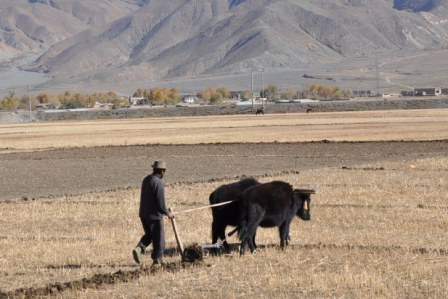 Traditional Farming
Traditional Farming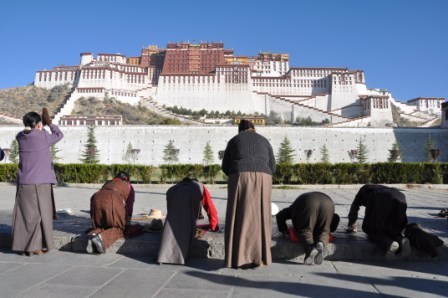 Piety in front of the Potala Palace
Piety in front of the Potala Palace
 Tuesday, February 23, 2010 at 5:00PM | by
Tuesday, February 23, 2010 at 5:00PM | by  Giller
Giller 